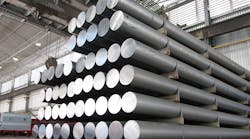What's Ahead for Aluminum Prices with US Tariffs on Russia?
One of the biggest uncertainties in the global aluminum market heading into 2023 was whether the United States and its allies would levy economic sanctions against Russia aluminum over the ongoing war in Ukraine.
The Russian aluminum industry is a key part of its defense industrial base, and the nation also is one of the world’s largest producers of the metal. The U.S. and its allies imposed several economic measures against Russia after it invaded Ukraine a year ago but did not target aluminum.
It’s important to remember what happened in 2018 when the U.S. sanctioned United Co. Rusal, a major Russian aluminum producer, in response to Russian aggressions, including meddling in U.S. elections. The punishment, which froze the bulk of the company’s exports, jolted the aluminum market and sent aluminum prices soaring.
With that in mind, aluminum buyers and sellers were anxious about 2023. They received some clarity at the end of February when the White House announced that the U.S. will impose 200% tariffs on Russian aluminum. The 200% duty also will apply to aluminum imports from elsewhere that include Russian aluminum. The tariffs were part of a larger package of trade enforcement moves against Russian metals, minerals and chemicals worth about $2.8 billion that were announced on the one-year anniversary of Russia’s invasion.
While tariffs usually lead to higher prices, the impact of this latest action against Russian aluminum will be muted on prices because of a confluence of factors, according to our commodity specialists. First off, the tariffs were not as punitive as other measures that the White House was considering, including a total ban on Russian aluminum imports and renewed sanctions on Rusal.
Decreased Dependence on Russia
The tariffs are unlikely to tighten aluminum supplies in the U.S., as users have lessened their reliance on Russian aluminum since 2017. At the time, Russia, primarily through Rusal, accounted for about 11% of U.S. aluminum imports. Its market share dipped to about 4% of import volume last year.
There are bigger macroeconomic and demand-side issues at play affecting aluminum prices than U.S. tariffs on Russian aluminum. Prices of the metal on the London Metal Exchange, the international benchmark, have fallen about 30% from a year ago and remain under pressure.
Global prices have been volatile since the pandemic. They began a steady climb in mid-2020, as economies slowly reopened following pandemic lockdowns and improving industrial demand. The metal is used to make everything from cars and planes to beverage cans and window frames. The growth of electric vehicles and renewable energy also has increased demand, as the metal is used to make solar components and battery packs.
At the beginning of last year, prices surged on supply concerns in the days and weeks leading up to Russia’s invasion of Ukraine. Prices continued rising after the start of the war as the U.S. and other western nations brought economic sanctions against Russia. The U.S. did not initially target Russian aluminum but the sanctions and the war led to increases in many commodity prices. Aluminum prices soared more than 30 percent in the first quarter of 2022.
But since peaking in March of last year, prices have tumbled. As some key buyers shunned Russian supplies, aluminum inventories began growing. Meanwhile, China, the world’s largest aluminum producer, kept its smelters humming and added to the oversupply. Despite production cuts in Europe and the U.S. due to high energy costs, worldwide aluminum production rose 2% last year, to 68.5 million tonnes, according to the International Aluminium Institute.
Economic slowdown cools demand in U.S. and Europe
The rise in global output came against growing worries that an economic slowdown would weaken demand for the metal. Europe’s energy crisis that was sparked by the war hammered the region’s industrial economy. Inflation and rising interest rates created recession fears in the U.S.
In addition, currency fluctuations have hurt aluminum prices. The Federal Reserve’s aggressive interest rate hikes to combat inflation have strengthened the U.S dollar relative to other currencies. As metals are priced in dollars in international markets, the strong dollar makes aluminum more expensive for holders of other currencies.
The difficult economic conditions of 2022 have continued into this year, lending a bearish outlook for aluminum. We expect aluminum prices to decline 3-5% overall in March because of an expected monthly rise in inventories at the London Metal Exchange and the possibility of further interest rate hikes in the U.S. to corral inflation. In addition, the S&P Global Manufacturing PMI for the U.S. continued to remain in contraction, reaching 47.3 points in February, leading to a slowdown in demand from downstream manufacturing activities. More recently, the uncertainty in the U.S. financial system amid the fallout of Silicon Valley Bank (SVB) may result in investors becoming more risk-averse and beginning to liquidate their positions in commodities (including base metals), leading to a drop in prices.
Impact of possible further sanctions and retaliations by Russia
There is one scenario that could push prices up and that is if Europe follows the U.S. in imposing tariffs on Russian aluminum or goes as far as banning the metal. The EU is more dependent on Russia for its aluminum supplies than the U.S., as Russia accounts for about 13% of imports. Supplies are already tight in the EU after smelters in the region shut down production because of soaring energy prices. So the war in Ukraine and further trade actions by western nations will continue to be top of mind in the aluminum market.
If Russia retaliates against the U.S. import tariff, it will likely lead to supply-side disruptions in the U.S. metals market, particularly in the nickel and palladium market. Russia is the largest global palladium producer, accounting for around 40% of global supply and contributing around 35% of total U.S. palladium imports in 2022. Additionally, approximately 11% of total nickel imports by the U.S. are sourced from Russia. These factors could significantly impact the U.S. metals market and global supply chains.
Vivek Aggarwal is a senior forecasting analyst at the Smart Cube.




